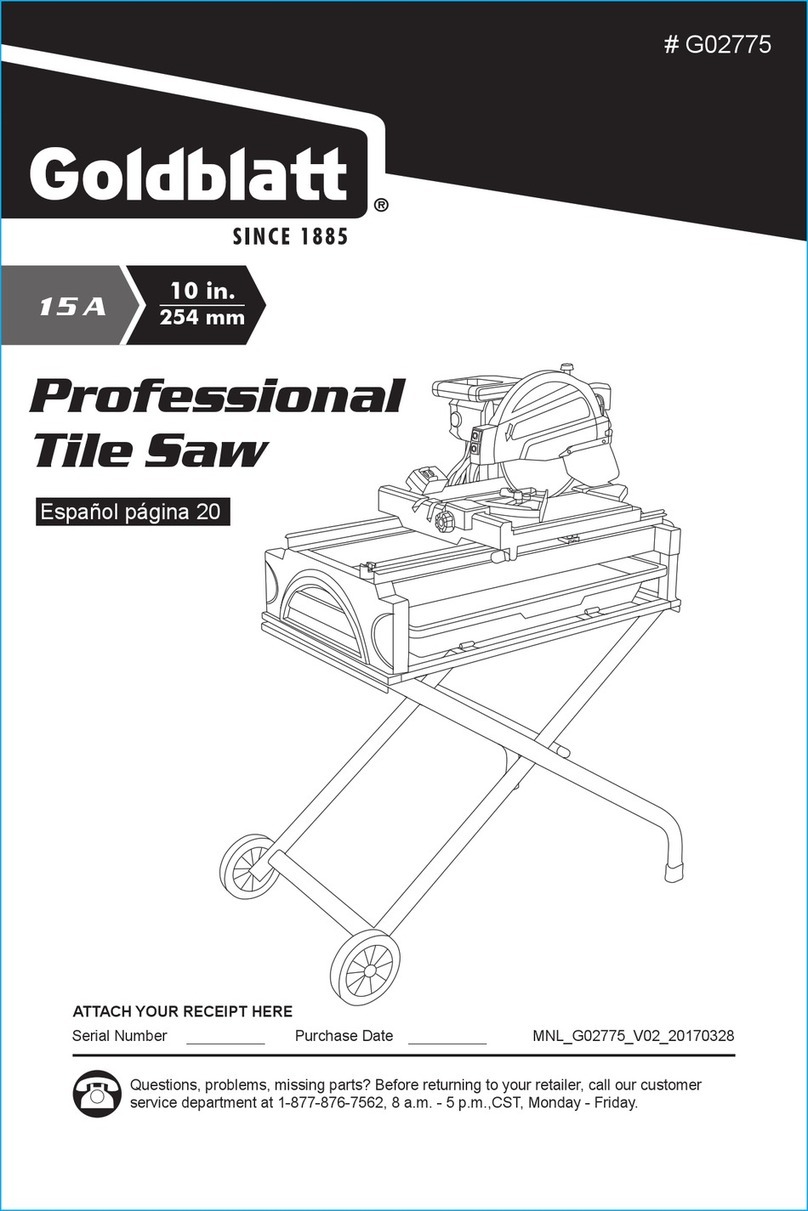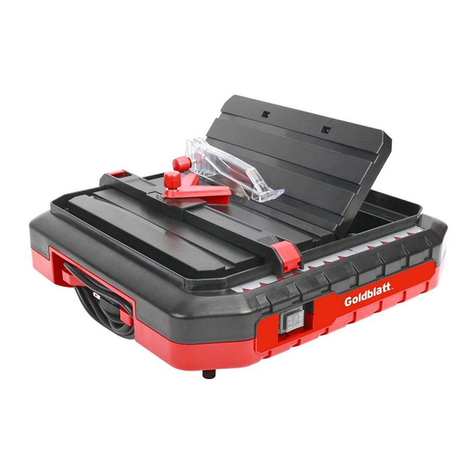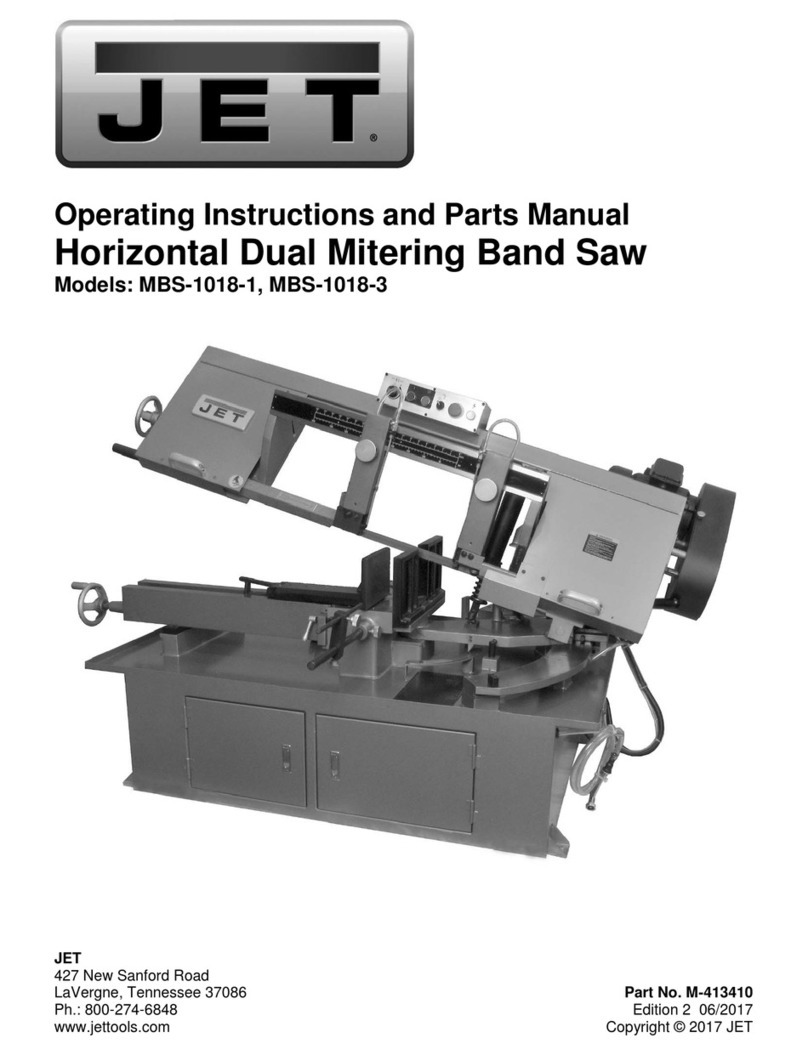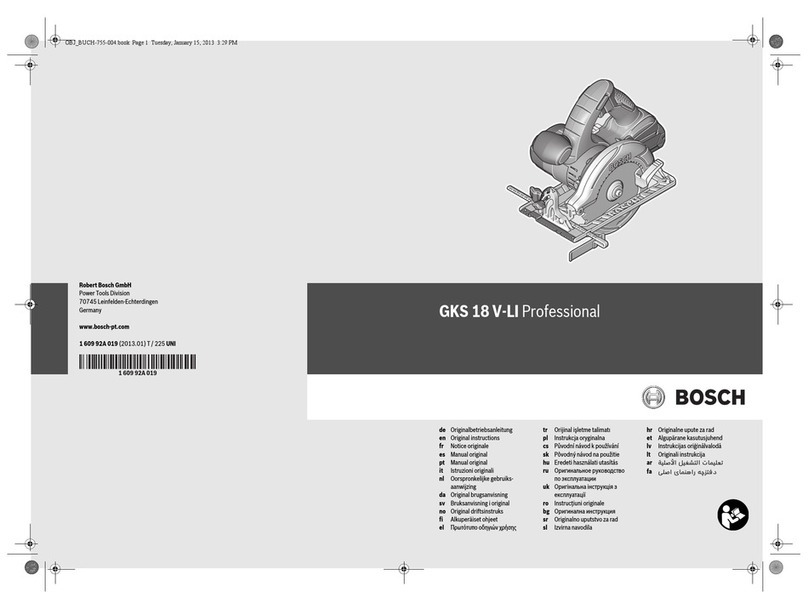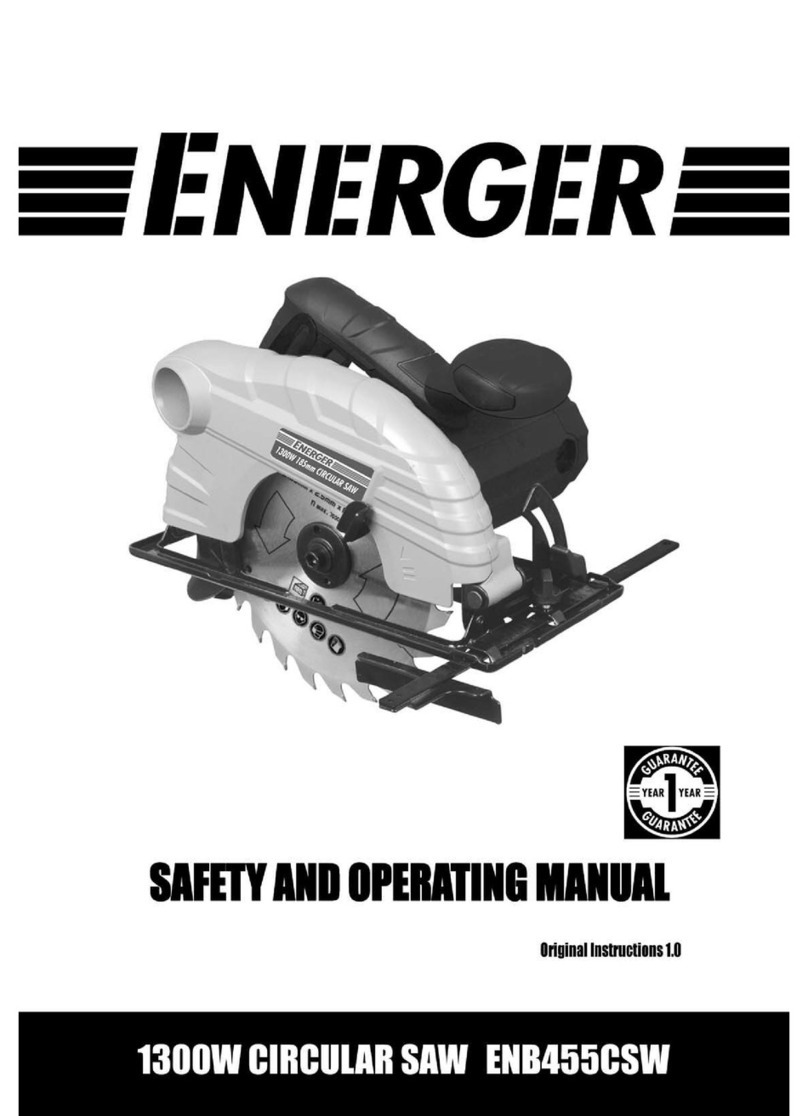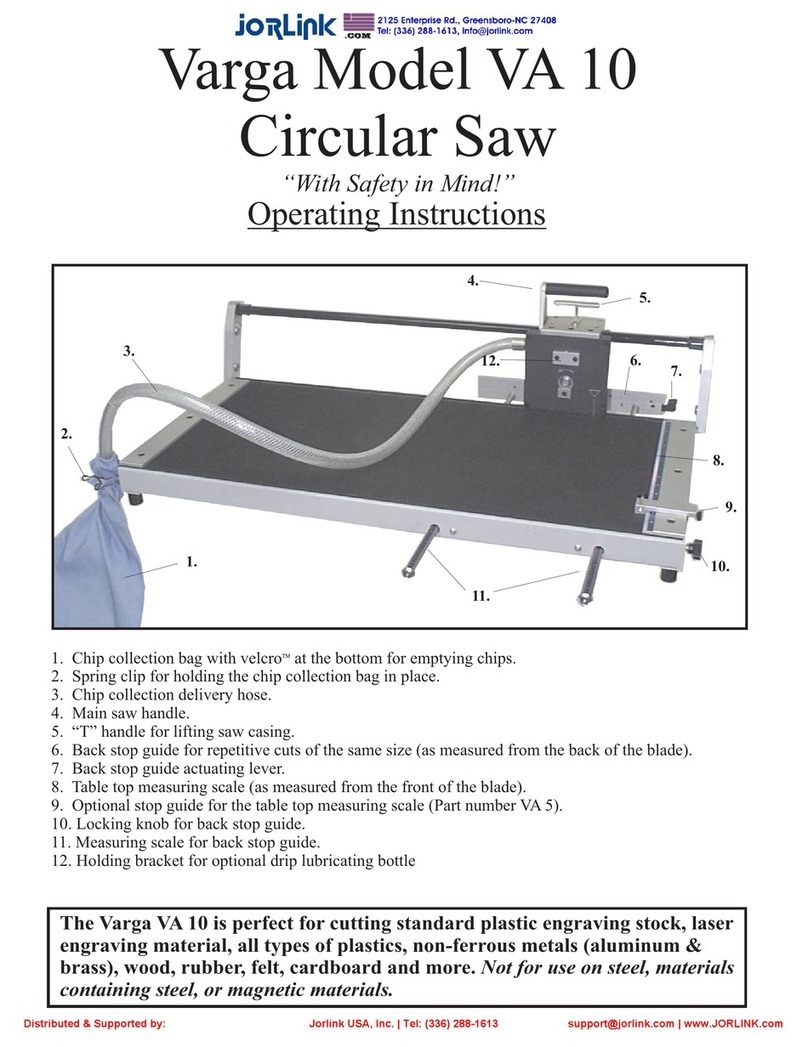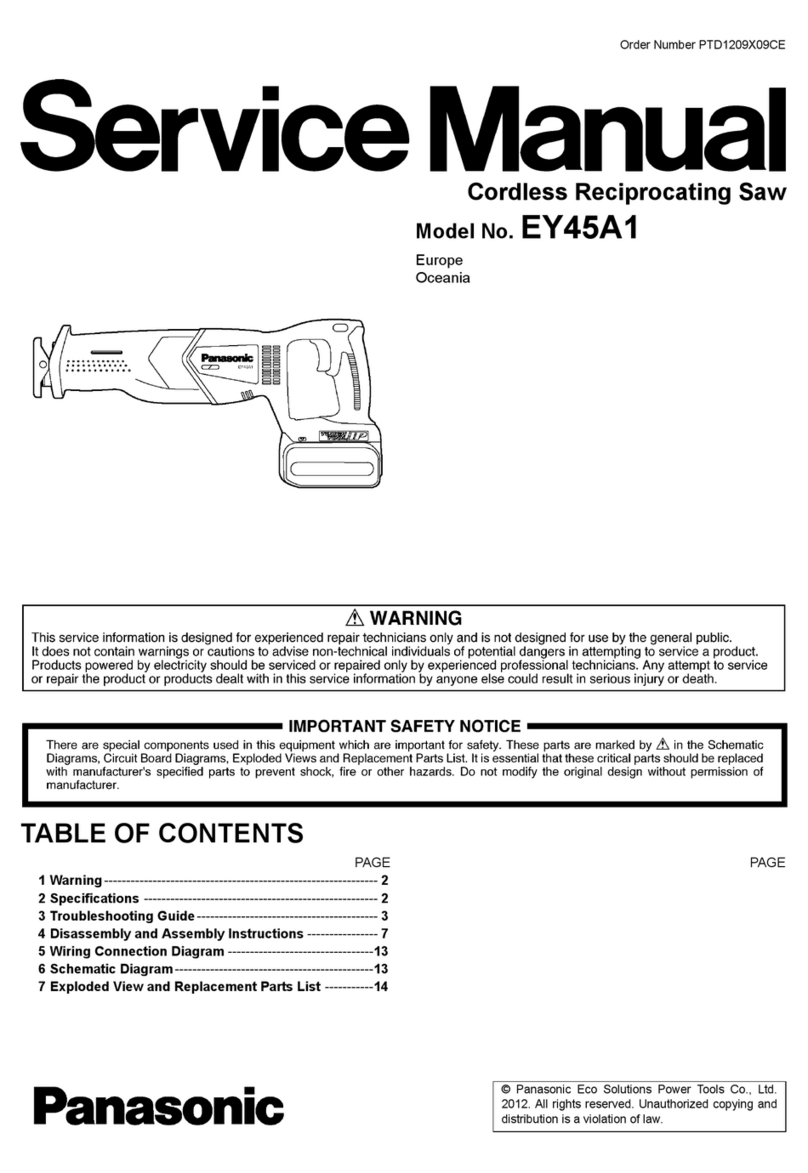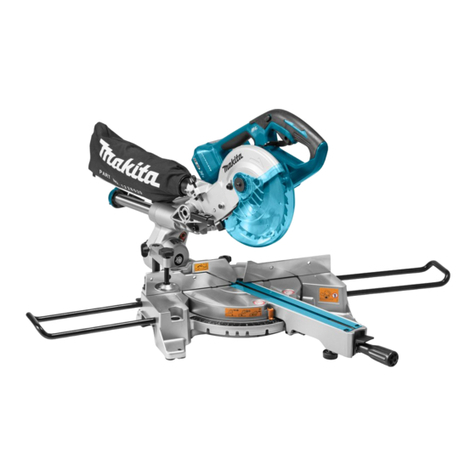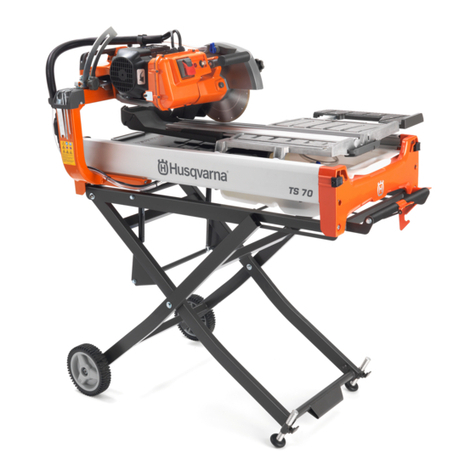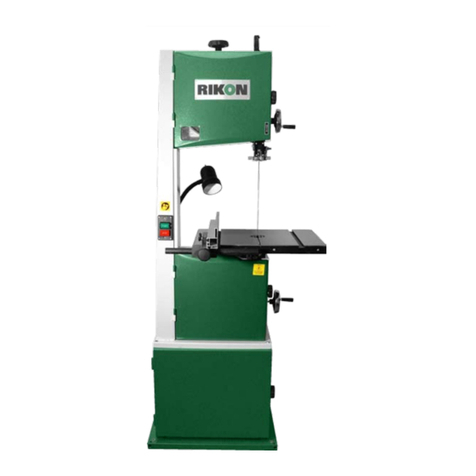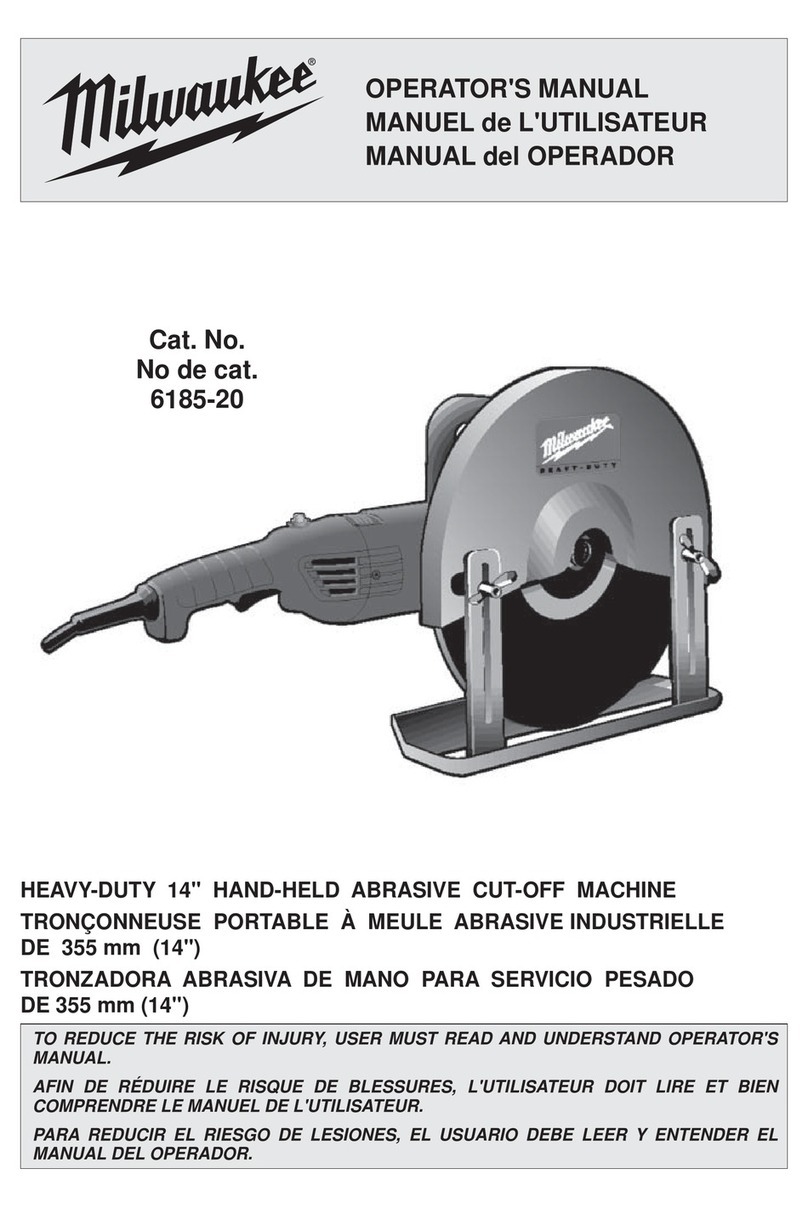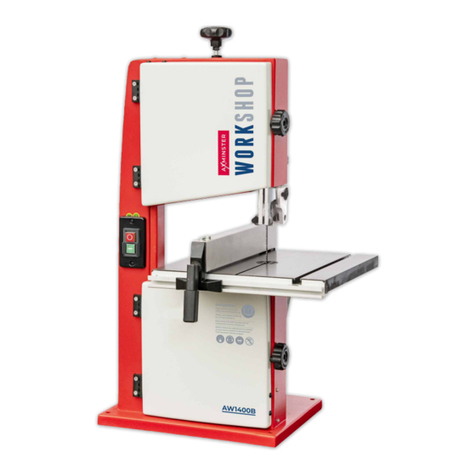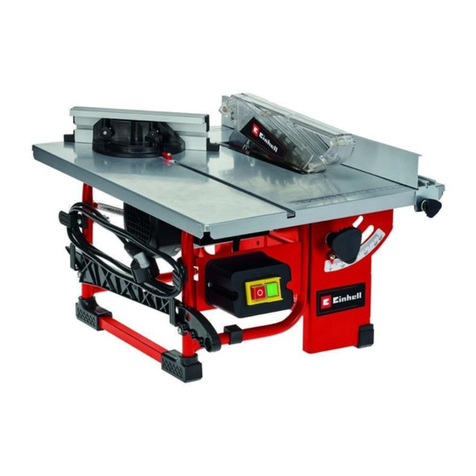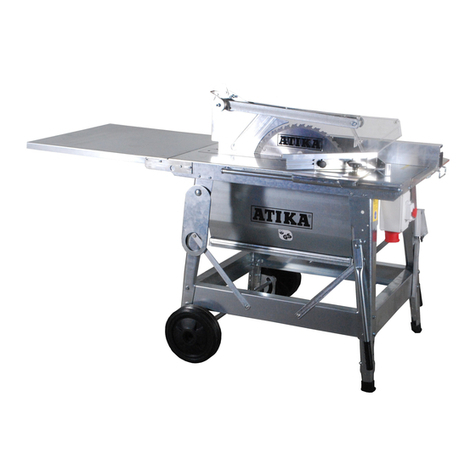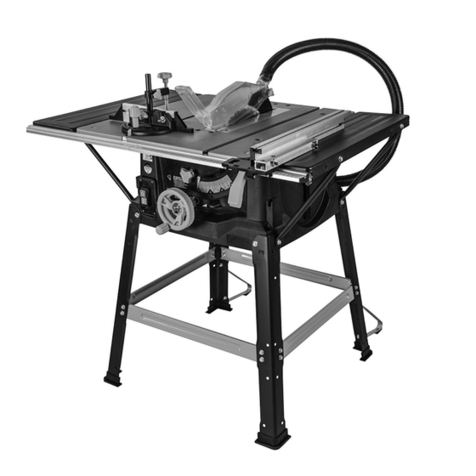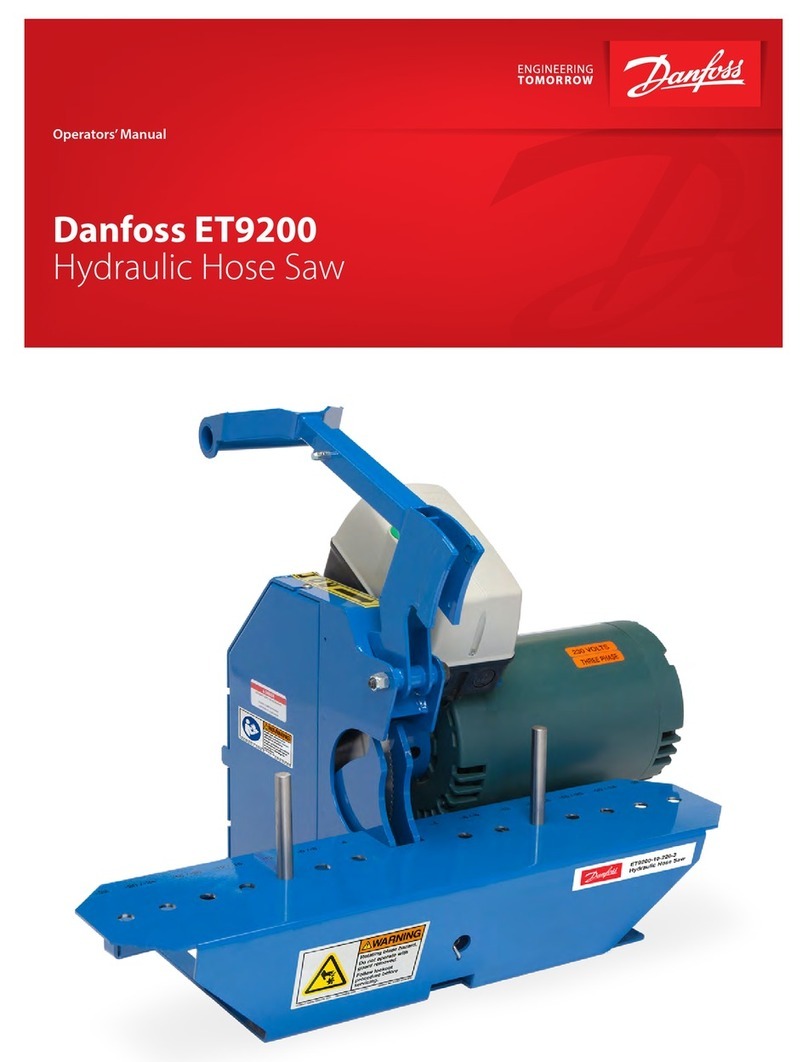Goldblatt G02773 User manual

®
Serial Number Purchase Date MNL_G02773_V02_20170328
ATTACH YOUR RECEIPT HERE
# G02773
Tile Wet Saw
Questions, problems, missing parts? Before returning to your retailer, call our customer
service department at 1-877-876-7562, 8 a.m. - 5 p.m.,CST, Monday - Friday.
7 in.
180 mm
5.0 A
Español página 21

2
TABLE OF CONTENTS
3
10
10
11
11
15
19
20
20
Safety rules............................................................................................................
Safety symbols......................................................................................................
Technical specifications........................................................................................
Package Contents.................................................................................................
Assembly...............................................................................................................
Operation..............................................................................................................
Maintenance.........................................................................................................
Troubleshooting guide..........................................................................................
Warranty...............................................................................................................

3
SAFETY RULES
Before Use
1. For safe handling of this product, the user must have read and
understood the instructions for use before using it for the first time.
2. Observe all safety instructions! If you do not observe the safety instructions
you will endanger yourself and others.
3. Keep all instructions for use and safety instructions for future reference.
4. Attach the instructions for use, if you pass on the product.
5. KEEP WORK AREA CLEAN. Cluttered areas and benches invite accidents.
6. All parts of the product, safety devices in particular, must be correctly
installed to ensure faultless operation.
OPERATION/WORKPLACE
1. KEEP GUARDS IN PLACE and in working order.
2. REMOVE ADJUSTING KEYS AND WRENCHES. Form habit of checking
to see that keys and adjusting wrenches are removed from tool before
turning it on.
3. KEEP CHILDREN AWAY. All visitors should be kept safe distance from
work area.
4. MAKE WORKSHOP KID PROOF with padlocks, master switches, or by
removing starter keys.
5. DON'T FORCE TOOL. It will do the job better and safer at the rate for which
it was designed.
6. USE RIGHT TOOL. Don't force tool or attachment to do a job for which it
was not designed.
7. DON'T OVERREACH. Keep proper footing and balance at all times.
8. REDUCE THE RISK OF UNINTENTIONAL STARTING. Make sure switch
is in off position before plugging in.
9. DIRECTION OF FEED. Feed work into a cutting disc against the direction
of rotation of the blade or cutter only.
10. NEVER LEAVE TOOL RUNNING UNATTENDED. TURN POWER OFF.
Don't leave tool until it comes to a complete stop.
WARNING
To avoid serious personal injury, do not attempt to use this product until you read
the manual thoroughly and understand it completely. Save this manual and
review frequently for continuing safe operation and instructing others who may
use this tool.

4
11. The product may be used only when in a faultless condition. If the
product or part of the product is defective, have it repaired by an expert.
12. Always follow the applicable national and international safety, health
and labour regulations.
13. The product may only be put into operation if no faults are found during
the inspection. Ensure that any defective parts are replaced before the
product is used again.
14. Position the product horizontally on a rigid, even surface with adequate
load-bearing capacity.
15. Do not leave any tools, objects or cables lying in the working range of
the device.
16. Ensure that there is sufficient lighting during operation.
17. Assume a natural and secure stance when working.
18. Make sure that during operation, no body parts or clothing are caught
and drawn in by rotating components.
19. The immediate environment must be free of combustible and other
flammable or explosive substances.
20. Young people under 18 years of age and users who are not sufficiently
familiar with its operation must not use the product.
21. Persons unable to safely and carefully use the tool for physical,
psychological and neural reasons must not use the product.
22. Work with caution and only if you are physically fit: Working under the
effects of fatigue, illness, alcohol, medication and drugs is irresponsible,
as you are unable to use the product safely.
SERVICE
1. DISCONNECT TOOLS before servicing; when changing accessories,
such as cutting discs and the like.
2. Have your electrical tool repaired only by qualified technicians, using
only genuine spare parts. This will maintain the safety of the electrical
tool.
3. DON'T USE IN DANGEROUS ENVIRONMENT. Don't use power tools in
damp or wet locations, or expose them to rain. Keep work area well lighted.
4. MAINTAIN TOOLS WITH CARE. Keep tools sharp and clean for best and
safest performance. Follow instructions for lubricating and changing
accessories.
SAFETY RULES

5
SAFETY RULES
5. CHECK DAMAGED PARTS. Before further use of the tool, a guard or other
part that is damaged should be carefully checked to determine that it will
operate properly and perform its intended function - check for alignment
of moving parts, binding of moving parts, breakage of parts, mounting,
and any other conditions that may affect its operation. A guard or other
part that is damaged should be properly repaired or replaced.
6. Only the maintenance work and troubleshooting activities described in
this instructions for use may be carried out. All other work must be
carried out by an expert.
7. Conversions, unauthorized modifications and the use of non-approved
parts are prohibited.
PRODUCT-SPECIFIC SAFETY WARNINGS
1. Make sure that you always stand to the side of the cutting disc.
2. WEAR PROPER APPAREL. Do not wear loose clothing, gloves, neckties,
rings, bracelets, or other jewelry which may get caught in moving parts.
Nonslip footwear is recommended. Wear protective hair covering to contain
long hair.
3. ALWAYS USE SAFETY GLASSES. Also use face or dust mask if cutting
operation is dusty. Everyday eyeglasses only have impact resistant lenses,
they are NOT safety glasses.
4. USE RECOMMENDED ACCESSORIES. Consult the owner's manual for
recommended accessories. The use of improper accessories may cause
risk of injury to persons.
5. NEVER STAND ON TOOL. Serious injury could occur if the tool is tipped
or if the cutting tool is unintentionally contacted.
6. Use only cutting discs that are suitable for the product.
7. Only use faultless cutting discs. Dismount damaged or worn cutting discs
immediately.
8. Never use segmented cutting discs.
9. Faults in the machine, including guards or diamond discs, should be
reported as soon as they are discovered. Never use the machine without
the guard in position.
10. Do not twist or bend workpieces.
11. Never cut several workpieces simultaneously - and do not cut bundles
made of several individual pieces. A workpiece can get caught in the
cutting disc and fly out of control.
12. Never cut workpieces on which there are ropes, cords, bands, cables
or wires containing such materials.

6
SAFETY RULES
13. Make regular checks to ensure that the cutting disc is correctly
fastened.
14. Make sure that during the cutting operation, an adequate quantity of
cooling water reaches the cutting surfaces of the disc at all times.
15. Never cut wood or metal with this saw.
16. Always maintain sufficient distance from the cutting disc. Switch off
the product and wait until the cutting disc stops before removing
workpieces, residual material etc. from the work area.
17. Always pull out the mains plug (disconnect the product from its power
supply) before commencing work on the product.
18. A cutting disc can cause injuries, even when stationary! Use protective
gloves to change the cutting disc.
19. Never use lateral counter pressure to bring the cutting disc to a
standstill after switching off the drive.
20. Replace table insert when worn.
21. Use only diamond discs recommended by the manufacturer.
22. Never use blades on this machine.
23. Use only diamond discs for which the maximum possible speed is not
less than the maximum spindle speed of the tool and the material to be
cut.
24. Maximum size of working piece should be 1m2.
25. This tile saw should be used at an ambient temperature only (between
15ºC and 30ºC).
26. USE PROPER EXTENSION CORD. Make sure your extension cord is in
good condition. When using an extension cord, be sure to use one heavy
enough to carry the current your product will draw. An undersized cord
will cause a drop in line voltage resulting in loss of power and overheating.
Table C on page 9 shows the correct size to use depending on cord
length and nameplate ampere rating. If in doubt, use the next heavier
gauge. The smaller the gauge number, the heavier the cord.
STORAGE AND TRANSPORT
1. Always store the product in a dry place.
2. Store the product in a frost-free place.
3. Protect the product from damage during transport.
4. Keep the product away from children. Store the product in a place where
it is safe from children and unauthorized persons.

7
SAFETY RULES
RESIDUAL RISKS
Even when the product is used properly and in compliance with all the
safety precautions in these instructions for use, the following residual
risks can arise:
• Touching the cutting disc in the exposed area.
• Reaching into the spinning cutting disc.
• Rebound from workpieces and workpiece parts.
• Cutting disc breaks.
• Faulty cutting disc diamond attachment being flung out.
• Hearing damage through failure to wear the requisite hearing protection.
WARNING
For your own safety read instruction manual before operating saw.
• Wear eye protection.
• Use splash hood for every operation for which it can be used.
• Disconnect saw before servicing, when changing cutting wheels, and cleaning.
• Use tool only with smooth edge cutting wheels free of openings and grooves.
• Replace damaged cutting wheel before operating.
• Do not fill water tank above water fill line.
• Do not expose to rain or use in damp locations.
ELECTRICAL SAFETY
A. GROUNDING INSTRUCTIONS (FIG. A)
Grounding methods (FIG. A)
GROUNDING
PIN
COVER OF GROUNDED
OUTLET BOX
In the event of a malfunction or breakdown, grounding provides a path of least
resistance for electric current to reduce the risk of electric shock. This tool is
equipped with an electric cord having an equipment-grounding conductor and a
grounding plug. The plug must be plugged into a matching outlet that is properly
installed and grounded in accordance with all local codes and ordinances.
Do not modify the plug provided - if it will not fit the outlet, have the proper outlet
installed by a qualified electrician.
Improper connection of the equipment-grounding conductor can result in a risk of
electric shock. The conductor with insulation having an outer surface that is green

8
SAFETY RULES
with or without yellow stripes is the equipment-grounding conductor. If repair or
replacement of the electric cord or plug is necessary, do not connect the
equipment-grounding conductor to a live terminal.
Check with a qualified electrician or service personnel if the grounding
instructions are not completely understood, or if in doubt as to whether the tool is
properly grounded.
Use only 3-wire extension cords that have 3-prong grounding plugs and 3-pole
receptacles that accept the tool's plug.
Repair or replace damaged or worn cord immediately.
B. POSITION OF TILE SAW (FIG. B)
DRIP LOOP (FIG. B)
TOOL
SUPPORTING SURFACE
POWER SUPPLY
CORD
DRIP LOOP
1. To avoid the possibility of the appliance plug or receptacle getting wet, position
tile saw to one side of a wall mounted receptacle to prevent water from dripping
onto the receptacle or plug. The user should arrange a "drip loop" in the cord
connecting the saw to a receptacle. The "drip loop" is the part of the cord
below the level of the receptacle, or the connector if an extension cord is used,
to prevent water traveling along the cord and coming in contact with the
receptacle.
2. If the plug or receptacle does get wet, DON'T unplug the cord. Disconnect the
fuse or circuit breaker that supplies power to the tool. Then unplug and
examine for presence of water in the receptacle.

9
SAFETY RULES
1. Use only extension cords that are intended for outdoor use. These extension
cords are identified by a marking "Acceptable for use with outdoor appliances;
store indoors while not in use." Use only extension cords having an electrical
rating not less than the rating of the product. Do not use damaged extension
cords. Examine extension cord before using and replace if damaged. Handle
extension cords carefully; do not yank on any cord to disconnect. Keep cord
away from heat and sharp edges. Always disconnect the extension cord from
the receptacle before disconnecting the product from the extension cord.
2. WARNING - To reduce the risk of electrocution, keep all connections dry and
off the ground. Do not touch plug with wet hands.
3. Ground Fault Circuit Interrupter (GFCI) protection should be provided on the
circuit(s) or outlet(s) to be used for the tile saw. Receptacles are available
having built-in GFCI protection and may be used for this measure of safety.
C. EXTENSION CORDS (FIG. C)
Minimum gauge for extension cords (FIG. C)
Ampere Rating
Volta
120 V 25 ft 50 ft
AWG
100 ft 150 ft
Total length of cord in feet
More Than
0
6
10
12
6
10
12
16
18
18
16
14
16
16
16
12
16
14
14
14
12
12
Not More Than
Not Recommended

10
TECHNICAL SPECIFICATIONS
Code
Model
Voltage
No load speed
Insulation class
Dimensions of the diamond disc
Working table size
Maximum cutting depth
Max. workpiece thickness for 45° jolly cut
Net weight
G02773
TC180V
120V~ 60Hz 5.0AMP
5300 RPM
Class I
7" x 5/8"
(180 x 16 mm)
13-9/16" x 13-9/16" (345 x 345 mm)
1-3/16" (30 mm) at 90°
15/32" (12 mm)
16.75 lbs (7.6 kg)
EXPLANATION OF SYMBOLS
Read instructions before use
Risk of electric shock
Risk of injury when instructions
are not followed
Wear ear protection
Wear eye protection
Wear suitable face mask
Wear gloves
Waste electrical products should
not be disposed of with household
waste
Wet conditions alert
Conforms to United
States

11
ASSEMBLY
This tile saw must only be used only to cut tiles to a required size or shape. It shall
not be used to cut inflammable, explosive or toxic materials. Other uses for the
machine will lead to the damage of the machine and a series of dangers to the
operator. This tool is for private and household use, not for professional or
industrial ones. Only identical accessories as the ones provided with the tile saw
are authorized. Never use the appliance in the rain or other wet conditions.
PACKAGE CONTENTS
32
7
8
4
5
69
1
1
2
3
4
5
6
7
8
9
Tile saw (assembled)
Rip Fence
Miter Guide
Upper Blade Guard
Saw Blade
Metal Bracket
Extension table and locking knob
Water Reservoir Plug
Sapnner
1
1
1
1
1
1
1
1
2
PART DESCRIPTION QUANTITY

12
ASSEMBLY
Unpacking
• Remove all packaging materials.
• Remove remaining packing and package inserts (if included).
• Check that the package contents are complete.
• Check the appliance, the power cord, the power plug and all accessories for
transportation damage.
• Keep the packing materials as long as possible until the end of the warranty
period.
WARNING
Packaging materials are not toys! Children must not play
with plastic bags!
Danger of suffocation!
FITTING THE CUTTING DISC (FIG.1-4)
• Unplug the tile cutter from the mains supply.
• Raise the 45° vertical fence (1) approx. 45° and remove.
• Loosen cross-screws (2) with the star-head screwdriver
(not supplied) and pull off lower protective guard (3).
• Attach the straight wrench (4) (supplied) to the hex nut (5).
• Lock motor shaft (6) to prevent turning using angled
wrench (7) (supplied).
• Turn the hex nut (5) anti-clockwise.
• Remove the hex nut (5) and outer flange (8).
• Place cutting disc (9) on inner flange (10).
• Attach the outer flange (8), the double “D” flats on the
outer flange align with flats on motor shaft.
• Screw hex nut (5) onto motor shaft (6) clockwise.
• Attach the straight wrench (4) to the hex nut (5).
• Lock motor shaft (6) to prevent turning using angle
wrench (7).
• Tighten hex nut (5) clockwise using straight wrench (4).
• Re-attach the lower protective guard (3) and tighten
cross-screws (2).
WARNING !
Be sure to observe the rotational direction of the cutting
disc when fitting! Be sure to observe the free-wheeling
of the cutting disc when fitting!
3
2
2fig.2
5
6
89
10
fig.4
fig.1
1
fig.3
6
5
6
7
4
85

CAUTION !
When fitting make sure that the cutting disc is placed correctly on the inner flange.
The inner flange can be moved freely on the motor shaft and has a section for
holding the internal hole of the cutting disc. The hole of the outer flange is not
round and is used for the interlocking connection with the motor shaft.
WARNING !
The metal bracket must always be aligned to the cutting
disc so that it does not Interfere with material being cut.
WARNING !
Product damage! Do not over-tighten hex bolt (3) and
locking knob (1). The upper protective guard (4) must be
free to rise and fall as the workpiece is pushed toward the
cutting disc.
13
ASSEMBLY
ASSEMBLE/ADJUST THE METAL BRACKET (Fig. 5)
• Loosen two cross-screws (1) with the Star-head
screwdriver (not supplied).
• Push slotted hole in the metal bracket (2) below the
cross-screw (1).
• Gently tighten the cross-screws (1).
• Align metal bracket (2) with the cutting disc (3).
• Tighten cross-screws (1).
• Replace the 45° vertical fence.
MOUNTING THE UPPER PROTECTIVE GUARD
(Fig. 6-7)
• Loosen the locking knob (1) and remove the locking knob,
flat washer (2) and hex bolt (3) from the upper protective
guard (4).
• Align upper protective guard (4) with cutting disc and
slide over metal bracket (5). Line up through holes in
upper protective guard with slot in metal bracket.
• Install hex bolt (3) through upper protective guard and
metal bracket. Put the flat washer (2) onto bolt before the
thread locking knob (1) and tighten the locking knob.
• Cover the cutting disc with the upper protective guard (4).
• Ensure that upper protective guard (4) can move freely
and that it cannot touch the cutting disc.
fig.5
3
3
1
1
2
2
fig.6
4
31 2
5
421 3
fig.7
fig.8
1
2
fig.9
2
MOUNTING THE EXTENSION TABLE (Fig. 8-10)
• Undo the cross-screws (1) on the guide rails of the
extension table (2).

14
ASSEMBLY
• Push the guide rails for the extension table (2) on both
sides into the locator of the machine body.
• Refit the cross-screws (1).
• Mounting the locking knob (3).
SETTING EXTENSION TABLE (Fig. 10)
• Loosen the locking knob counter-clockwise.
• Set the extension table to the desired distance from the
cutting disc.
• Tighten the locking knob clockwise.
MOUNTING THE PARALLEL CUTTING GUIDE (Fig. 11)
• Attach the rear end of the parallel cutting guide (1) to the
rear of the working table.
• Push the spring (2), clamp (3) and flat washer (4) onto
thread (5).
• Screw locking knob (6) onto thread (5) and turn it
clockwise to tighten securely.
ADJUSTING THE PARALLEL CUTTING GUIDE
• Gently turn locking knob on parallel cutting guide counter-clockwise to loosen.
• Use parallel cutting guide scale, located on front and rear of working table, to
set parallel cutting guide to desired width of cut.
• Turn locking knob clockwise to tighten securely.
INSTALLING THE MITRE CUTTING GUIDE (Fig. 12)
• Slide mitre cutting guide (1) onto parallel cutting
guide (2) from front.
• Adjust parallel cutting guide to desired position and secure.
• Adjust to desired angle using angle scale (3) and tighten
securely with locking knob (4).
NOTE:
The mitre cutting guide can be set to a desired angle
(0°-45°). The mitre cutting guide can only be used when
the parallel cutting guide is mounted.
INSTALLING THE WATER RESERVOIR PLUG (Fig. 13)
• Raise the 45° vertical fence approx. 45° and remove.
• Locate hole on bottom of water fill reservoir.
• Push water reservoir plug (1) into hole firmly.
• Replace 45° vertical fence.
fig.12
4
31
2
fig.10
1
2 3
fig.11
1 5 2 3 4 6
1
fig.13

CAUTION !
• Fill the product with water only until water can drain from
the opening in the plug. During use the water level must
never drop below the MIN marking (1). (Fig. 14)
• Product damage! Fill the tank only with clear water. Never
use chemicals or cleaning agents. This can cause
irreparable damage to the product.
15
ASSEMBLY
OPERATION
FILLING THE WATER RESERVOIR (Fig. 14)
• Raise the 45° vertical fence approx. 45° and remove.
• Push water reservoir plug into hole firmly.
• Fill the reservoir with water only until water can drain from the opening in the plug.
• Ensure that water just cover the disc edge (no more than ¼ of the disc is
submerged in water).
• Replace 45° vertical fence.
TO CHANGE RESERVOIR WATER
• Unplug tile saw.
• Remove the water reservoir plug and empty into a bucket do not allow water to
splash onto ground or around machine.
• Discard waste water in accordance with local regulations.
fig.14
1
MIN
MIN
CHECK BEFORE STARTING!
• The product must be mounted on a stable surface, i.e. on a workbench.
• If a malfunction occurs, turn switch off and unplug the main plug.
• The product may be put into operation only if no defects or errors are found.
Ensure that any defective part is replaced before the product is used again.
Check that the product is safe before plugging in the power cable:
• Check whether there are any visible defects or faults.
• Check whether all parts of the product are firmly attached.
• Check that the safety devices are in good working condition.
• Check that the cutting disc can run freely.
• Check there is sufficient cooling water in the reservoir.
Stop the machine immediately if there is excessive vibration or some other fault.
If this situation continues, check the machine to find the origin of the fault.
This tile saw shall be used only to cut tiles to a required size or shape. It shall
not be used to cut inflammable, explosive or toxic materials. Other uses for the
machine will lead to the damage of the machine and a dangerous situation for
the operator. This appliance is for private and household use, not for
professional or industrial uses. Only identical accessories as the ones
provided with the tile saw are authorised. Never use the appliance in the rain
or other wet conditions.

WARNING !
• Before switching the tile saw on, make sure that you have read and understood
all of the safety instructions. Make sure also that the machine has been correctly
assembled and adjusted. Make sure that the mains is disconnected from the
supply when the tile cutter is not being used or adjustments are being made.
• Maintain an adequate distance from the cutting disc when cutting.
• Do not reach into the working range of the spinning cutting disc while the
product is operating.
CAUTION !
• Product damage! Carefully check the workpiece to be cut. Foreign bodies such
as nails, screws or similar items can seriously damage the product.
• The product is not suitable for cutting materials such as marble, fine stoneware
and granite. Tile floor made up of these materials must not be cut.
• Wait until the cutting disc has reached its maximum speed before
commencing work.
• Before commencing work, ensure that there is sufficient cooling water in the
reservoir.
• In the case of complex cuts (mitre or bevel) we recommend making a test cut
before the real cut.
• The disc will continue to rotate for a few seconds after the machine has been
switched off. Wait for the disc to stop before removing the workpiece or making
any adjustments.
ON/OFF SWITCH (Fig. 15)
• To turn the tile saw On, insert the safety key (1) into the
switch housing. As a safety feature, the switch cannot be
turned On without the key.
• Flip the switch upward to the On position.
• To turn the tile saw Off, move the switch to the down
position.
• To lock the switch in the Off position, remove the safety key from the switch.
Store the key in a safe place.
MAKING CUTS
Always draw the line to be cut on the tile using a marker or grease pencil. If the
tile is shiny and hard to mark, place masking tape on the tile and mark the tape.
A common problem when cutting tile is straying from the marked line. Once
you’ve strayed from the mark, you can not force the cutting disc back to the line
by twisting the tile. Instead, back up and recut the tile, slicing off a small amount
of tile until the cutting disc is back on track.
To avoid this problem, use the parallel cutting guide when making cross cuts, the
mitre cutting guide for mitre cuts and the tilting 45° vertical fence for making
bevel cuts, whenever possible.
16
OPERATION
1
fig.15

fig.16
3
3
4
2651
fig.17
USING THE PARALLEL CUTTING GUIDE AND
MITRE CUTTING GUIDE (Fig. 16)
The parallel cutting guide (1) can be used from both the left
and right side of the cutting disc.
• Gently turn locking knob (2) on parallel cutting guide
counter-clockwise to loosen.
• Adjust the parallel cutting guide in the desired position
using the parallel cutting guide scale (3), located on front and rear of table, to set
parallel cutting guide to desired width of cut.
• Turn locking knob clockwise to tighten securely.
To adjust angles:
• Slide mitre cutting guide (4) onto parallel cutting guide from the front.
Adjust parallel cutting guide to desired position and secure tightly.
• Adjust to desired angle using angle scale (5) and tighten securely with mitre
cutting guide locking knob (6).
TO MAKE A CROSS CUT (Fig. 17)
• Cross cuts are straight 90° cuts. The material is fed into
the cut at a 90° angle to the cutting disc. Using a marker
or grease pencil, mark the area to be cut on material.
• Adjust parallel cutting guide to desired position and
secure tightly.
• Place the material on the table and firmly against the
parallel cutting guide.
• Make sure the material is clear of the cutting disc before turning on the saw.
• Turn the On/Off switch to the ON position.
• Let the cutting disc get up to full speed and wait for the cutting disc to get wet
before moving the material into the cutting disc.
• Hold the material firmly against the parallel cutting guide and feed the material
into the cutting disc.
• When the cut is made, turn the saw OFF. Wait for the cutting disc to come to a
complete stop before removing any part of the material.
TO MAKE A 45° DIAGONAL CUT (Fig. 18)
45° diagonal cuts are also referred to as “cross cut”.
• Using a marker or grease pencil, mark the area to be
cut on material.
• Slide mitre cutting guide onto parallel guide from front.
• Set the parallel cutting guide to desired width, and tighten
the locking knob to secure in place.
• Adjust mitre cutting guide to 45° using angle scale and tighten securely with
locking knob.
• Make sure the material is clear of the cutting disc before turning on the saw.
• Turn the On/Off switch to the ON position.
17
OPERATION
fig.18

• Let the cutting disc get up to full speed and wait for the cutting disc to get wet
before moving the material into the cutting disc.
• Hold the material firmly against the mitre cutting guide and slide mitre cutting
guide along parallel cutting guide. Feed the material into the cutting disc.
• When the cut is made, turn the saw OFF. Wait for the cutting disc to come to a
complete stop before removing any part of the material.
TO MAKE A MITRE CUT (Fig. 19)
Mitre cuts are used for cutting outside and inside corners on
material, decorative chair rails and base moldings with the
material at any angle to the cutting disc other than 90°.
Mitre cuts tend to “creep” during cutting. This can be
controlled by holding the workpiece securely against the
mitre cutting guide.
• Using a marker or grease pencil, mark the area to be cut on material.
• Slide mitre guide onto parallel cutting guide from front.
• Set the parallel cutting guide to desired width, and tighten the locking knob to
secure in place.
• Adjust mitre guide to desired angle, using angle scale, and tighten securely with
locking knob.
• Make sure the material is clear of the cutting disc before turning on the saw.
• Turn the On/Off switch to the ON position.
• Let the cutting disc build up to full speed and wait for the cutting disc to get wet
before moving the material into the cutting disc.
• Hold the material firmly against the mitre cutting guide and slide mitre cutting
guide along parallel cutting guide. Feed the material into the cutting disc.
• When the cut is made, turn the saw OFF. Wait for the cutting disc to come to a
complete stop before removing any part of the material.
TO MAKE A BEVEL CUT (Fig. 20-21)
Beveled 15°, 30° and 45° cuts can be made using the 45°
vertical fence.
• Using a marker or grease pencil, mark the area to be cut
on material.
• Raise up the 45° vertical fence.
• On the underside of the 45° vertical fence, pull down the
two table legs (1) into right angles of the plate.
• Use first notches in legs to rest plate at a 15° angle (2).
• Use second set of notches to angle the 45° vertical fence
into a 30° angle (3).
• Use third set of notches to angle the 45° vertical fence
into the highest 45° angle (4).
• Fold legs up and lay the 45° vertical fence flat for
a 0° angle.
• Turn the On/Off switch to the ON position.
18
OPERATION
fig.19
fig.21
fig.20
1 1
2
4
3

• Let the cutting disc get up to full speed and wait for the cutting disc to get wet
before moving the material into the cutting disc.
• Hold the material firmly against the 45° vertical fence and feed the material into
the cutting disc.
• When the cut is made, turn the saw OFF. Wait for the cutting disc to come to a
complete stop before removing any part of the material.
NOTE:
Make sure the 45° vertical fence is locked firmly in place before beginning cut.
19
OPERATION
MAINTENANCE
Make sure that the saw is turned off and unplugged from power source before
installation, before cleaning and maintenace operations.
Apart from diamond discs, there are no other user serviceable parts inside this tile
saw. Refer to qualified service personnel if internal maintenance is required. Any
worn, or damaged parts should be replaced immediately by qualified personnel.
Keep discs in good condition. Poor condition or worn discs can increase the noise
level emitted.
Do not allow dust to accumulate inside, or on the product. After use, clean all
excess dust from the table and the area around the table. Frequently clean the
machine using a soft brush or vacuum cleaner.

20
TROUBLESHOOTING GUIDE
Danger of death!
Improper repairs can result in the product functioning unsafely.
This endangers yourself and your environment.
Malfunctions are often caused by minor faults. You can easily remedy most of these
yourself. Please consult the following table. You will save yourself a lot of trouble
and possibly money too.
SYMPTOM POSSIBLE
CAUSE(S)
CORRECTIVE
ACTION
Motor not running.
Motor runs, cutting
disc remains still
when subject
to load.
Cutting disc runs
irregularly/vibrates.
Cutting disc is
discoloured.
No mains voltage?
Flange nut loose?
1. Cutting disc warped?
2. Cutting disc fitted
incorrectly?
1. Insufficient cooling
water?
2. Lateral friction caused
by cut runout?
Check cable, plug,
socket and fuse.
Check the flange is
seated correctly and
tighten if necessary.
1. Replacing the cutting disc.
2. Fit the cutting disc
correctly.
1. Filling the product
with water.
2. Guide workpiece through
cutting disc more slowly.
ONE-YEAR LIMITED WARRANTY
The manufacturer warrants this item against defects in materials and
workmanship for one (1) years from the date of purchase. If within this period the
product is found to be defective in material or workmanship, the manufacturer will,
at its option, repair, replace or refund the original purchase price to the customer.
Please keep the original sales receipt as proof of purchase and call
1-877-876-7562, 8 a.m. – 5 p.m., CST, Monday – Friday for warranty service.
This warranty is void if product is used for commercial purposes. This warranty is
not transferable and does not cover products damaged by misuse, neglect,
accident, alterations or use and maintenance other than that specified in the
owner's manual. This warranty does not apply to any expendable parts that can
wear from normal use.
As some states do not allow exclusions or limitations on an implied warranty, the
above exclusions and limitations may not apply to you. This warranty gives you
specific legal rights, and you may have other rights that vary from state to state.
Table of contents
Other Goldblatt Saw manuals
